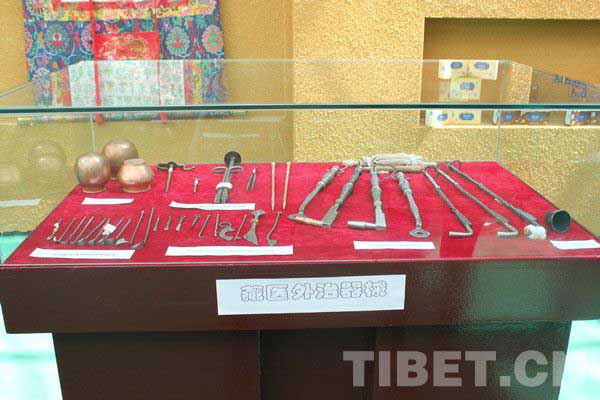In November 2012 I witnessed the substandard medical condition of a hospital in Dingri County, Tibet Autonomous Region by chance. It has gone beyond my expectations given its high altitude and remote location; and it will be updated in 2013.
After all,present health condition of Tibetan people have been greatly improved, especially the old, women and children.
Now over half of Tibetan pregnant women choose to give birth at hospital, where professional doctors, experienced midwives, strictly-sterilized delivery rooms and defined equipment have drastically reduced the mortality rate of pregnant women and infants.
At present, the mortality rate of lying-in women has dropped below 1.75 ‰ and that of new-born babies to 20.69‰ from 5 percent and 430‰ respectively in the early years after the peaceful liberation of Tibet (1951).

Photo shows that a cataract patient is waiting for unlocking goggles.
Volunteer medical service and free health check-up offered to Tibetans
"Thank you for coming here to give medical care to us. You have saved my kid's life!" A moving story took place during a volunteer medical consultation in Chamdo Prefecture in the east of Tibet Autonomous Region, where a Tibetan villager Losang had his little daughter cured by a Tibetan doctor, who diagnosed the illness as acute pneumonia when he gave volunteer medical consultation in the Township.
In the year 2012, there have been many similar cases. Medical staff and volunteers, both local and inland, both Tibetan and other ethic groups, have been working together in remote areas to improve local medical conditions and save lives. Commonly-used drugs, disease-prevention and healthcare brochures have also been distributed to local residents free of charge by the volunteers.
"We are quite grateful that local doctors give us free treatment," said Tsesum, a Tibetan grandma aged nearly 70, who waited early for the doctors and nurses to come for a physical check-up.
At the same time, free physical examinations have also covered all over Tibet, where free check-ups were carried out in full swing in 2012, which has benefited nearly three million urban and rural residents.
Tibetan monks and nuns have not been left out. They have been offered free physical examination including blood test, electrocardiographic examination and color Doppler ultrasonography.
Medical workers have also consulted monks and nuns on their physical conditions and offered medical tips in daily life to raise their health awareness during the check-ups, after they have enjoyed free medical care, even free surgeries in hospital with their health guaranteed.
In the future, Tibet will build up a regular free health check-up mechanism to improve people's livelihood.

Photo shows that an inland doctor examines the eyes of a Tibetan grandma at Tibet Tibetan Medical Hospital in Lhasa.
Traditional Tibetan medicine further develops
The time-honored Tibetan medicine plays an important role in improving Tibetans' lives. Now the ancient medicine has been further promoted home and abroad. In June 2012, a seminar was held to introduce Tibetan medicine during a Tibetan delegation's visit in Berlin, Germany.
In Lhasa on August 26, 2012, eight descendants of Tibetan medicine were awarded Master or Doctor degrees of Medicine, the highest academic degree of Tibetan medicine since Tibet's peaceful liberation in 1951.
As to construction hospital, in 2012 the expansion ceremony for Tibetan Medicine Hospital was held according to the Tibetan custom at the hospital in Lhasa, capital of southwest China's Tibet Autonomous Region, has enriched its functions after being finished.
A Dictionary on Tibetan Medicine and Calendric system has also been compiled, after a research on more than 1,000 works on Tibetan medicine was carried out. Taking in some 7,000 entries listed in the Tibetan aliphatic way, it is the first dictionary on Tibetan medicine and calendaric system available today.

Photo shows Tibetan medical equipment exhibited at the first Tibet intangible cultural heritage achievement exhibition.
Full social welfare coverage achieved with more governmental investment
Tibet has become the first Chinese autonomous region to extend its old-age pension coverage to all senior citizens in 2012.
According to the prevalent scheme, every senior citizen aged over 60 receives 55 yuan (8.7 U.S. dollars) a month as a basic pension allowance without having to pay any premiums.
And the financial authorities in Tibet has also invested 1.42 billion yuan (US$225 million) in health services in 2012, up 31.3 percent compared with that of last year.
The government has spent 630 million yuan on free medical services for farmers and herders and the medical insurance system improvement for urban residents, said an official of Tibet Finance Department.

Photo shows monks lining up to have eyesight checkups at the Lhasa People's Hospital in the Tibet Autonomous Region.
